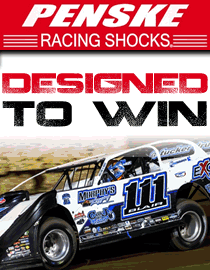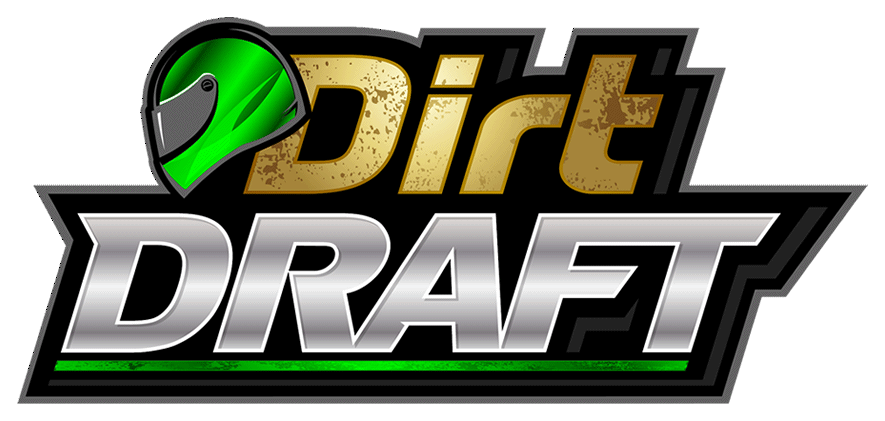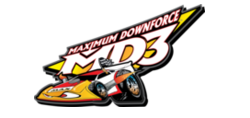
Farmer City Raceway
Video, apps critical for instant qualifying info
By Todd Turner
DirtonDirt.com managing editorFARMER CITY, Ill. — As the final qualifier during Illini 100 weekend at Farmer City Raceway, Jason Feger wanted to have every scrap of information he could about previous time-trialers before his No. 25 tripped the clock.
Wife Abby watched qualifying, texting pertinent information to the crew. Crew chief Jason Palubicki climbed the grass ledge above turn four, peering through the fence to keep an eye on the track. With Feger buckled in his Longhorn Chassis in the nearby lineup chute, crew member David Karban cradled an iPad to show Feger DIRTVision coverage through the driver’s side window. The Bloomington, Ill., driver had one hand on the steering wheel, one holding a smartphone that displayed live qualifying times on the MyRacePass app.
Each team member was focused on letting know Feger every last-second detail about how his fellow World of Outlaws Late Model Series event entrants turned the fastest laps.
With WoO director Steve Francis preparing to wave Feger onto the track, Palubicki skittered down the outside of the turn four banking and joined Karban for a brief conversation with Feger. Palubicki headed back toward the track, then wheeled around and headed back to his driver, sticking his head in the cockpit for one last discussion with Feger over the din of engines.
“Did you see what they did?” the crew chief remembered asking Feger. “Get on the tires down there and be on the top down here. Get all you can down here and get on the tires.”
With Palubicki returning to his perch, Karban pulled the iPad away and folded it shut, taking the phone from Feger, who Francis signaled to the track. Feger pulled his Late Model onto the track and mashed the accelerator.
Feger's goal? To use every bit of visual and recorded data — track conditions, live lap times and streaming video — to give him the best chance for the fastest qualifying lap. Per Palubicki’s instructions, Feger aimed to run as low as possible in turns one and two, then in the high groove against the outside wall in turns three and four.
Consider it mission accomplished as Feger’s 12.824-second lap was fastest in his group, giving him a coveted pole position for his heat race.
“You've got somebody watching (the track), he's watching the screen and we're also watching the phone. So you have three things now to see where people are at and where the fast lane is,” Palubicki said. "It obviously worked out tonight.”
The choreographed crew dance during time trials to keep drivers informed is performed scores of times throughout the season, just another way technology has brought grassroots dirt racing into the 21st century.
“It's instant. Even with just the timing on your phone (teams know if running the high groove is) a good thing to do, or no, that's a bad thing to do,” said Danny White, crew chief for Brandon Sheppard and the Rocket Chassis house car team. “It used to be you want to be parked as close to the tracks so you could watch and see everything, and now it's not a big deal because you just pull it up on your phone.”
Technological tools at the disposal of race teams far exceeds that of the previous generation. Years ago, drivers might have a crew member check the track and signal a lane choice. In other cases, drivers might choose a groove on a whim. With few tracks having even a scoreboard to reveal lap times many years ago, other crew members used stop watches to gauge lap times and provide insights on qualifying strategy.
Palubicki started crewing more than 20 years ago, and if he wasn’t operating a stopwatch himself, he’d sidle up next to longtime Dennis Erb Jr. crew chief Heather Lyne, or perhaps Gail Gruendler, who often kept lap times for late Hall of Famer Scott Bloomquist.
"You're going to watch the track. I usually stood next to Heather Lyne because she was the best with four stopwatches. She always knew,” Palubicki said. “(Gruendler was) another one that would sit there and write everybody down. So if you were close to them, you had an advantage. But back then it was hard. You had to have somebody watching. You had to have somebody that was good with a stopwatch, somebody that could read a racetrack. So now you've eliminated a lot of that.”
Things evolved when transponder scoring developed, but it wasn’t until the maturation of smartphones that users were able to have lap times immediately. Streaming video added another element.
"I started in 2011 out running the (World of) Outlaws and half the time, unless this track had a scoreboard, there was nights you didn't know (lap times). You're like, I think that (lap) was pretty good,” White said. “What they first did was they had live timing, but you didn't have it on your phone, but they had it in the (series) trailer. So there was a big crowd around the trailer. And then sometimes you’d have a (crew) guy up at the track and one of the trailer saying ‘Hey, this guy did this, this guy did that,’ so there was almost more moving parts sometimes with that.”
At Farmer City, most of the highest-level teams had some combination of monitoring lap times, watching the track and providing a way for drivers to watch the DIRTVision stream.
Even before heading toward the track, Devin Moran of Dresden, Ohio, sat in the driver’s seat in the pit area watching video on his phone of time trials for the Xtreme Outlaw Series midgets. (“I’m surprised he’s not watching golf,” cracked crew chief Chuck Kimble, who knew Moran had been tracking the weekend's CBS coverage of the Masters). When Moran headed to the lineup chute, he continued watching DIRTVision while crew member Nick “Two-Tone” Smith stood alongside, holding up a second phone to show lap times.
As Bobby Pierce’s car crept closer to the track for time trials, the WoO points leader held two phones as he sat in the cockpit: one for lap times, one with streaming video. Occasionally, he’d need to click on a driver’s name on MyRacePass. Because Pierce's bulky fireproof gloves didn’t trigger the touchscreen, he’d gesture to a crew member, who would dutifully oblige with a helpful tap.
“We try to get all the information we can,” Feger said. “Some tracks, you can see on a jumbotron. Like Eldora (Speedway), you can really see good on the jumbotron and see the (lap) times, or other places when they have (a video screen) there, and sometimes you can just see the track good in the lineup chute.
“But like here, there’s not a great place to get there to really watch (qualifying) as a driver and be ready to go at the same time. In the lineup chute, you can't see the track at all, so definitely we take advantage of trying to see (video).”
The system isn’t always perfect. Cell phone reception can be dodgy. Sometimes video coverage doesn’t include the complete qualifying laps of every car. And streaming video is delayed by as much as a minute, meaning the laps of competitors just before a driver’s qualifying lap can’t be seen.
With the live timing and video, teams "have that instant (information). If somebody changes a line and goes quicker, everybody knows,” White said. “Before it was kind of a crapshoot. A guy would (change grooves) and you’d say, ‘I think that was good,' but you don't know.
"I still feel like sometimes it's just a better look live, when you can see it in person. And they've gotten better now, but before, I feel like sometimes (video streams would) focus on one car at a time, so you didn’t know (about every qualifier). They might do one guy for a lap, another guy for a lap, so you still might miss what that other guy did.”
Streamers utilizing multiple cameras to show multiple qualifiers simultaneously is ideal, Feger said, and he doesn’t mind the delay.
“It's actually nice that DIRTVision is a little bit delayed, because you can see the Race Monitor (lap times) and see who went good and then (watch their lap),” Feger said. “And tonight, the Outlaws were doing the split screen, so that helps a lot. You get to see both guys do both complete laps.”
Things are smoother at bigger events “like an Outlaw or a Lucas or a Flo race where we got good coverage, but some of the other races we don't have as good coverage,” Feger said. “We've got one camera or something like that. It can make it harder — or you might not have phone service at some places.”
If issues prevent the team from using video or live scoring, it can be discombobulating, Palubicki said.
“You feel very naked like if you don’t. 'Oh (no), I need a stopwatch!' You’re (quickly) trying to get your phone (to the) stopwatch (app),” said Palubicki, who has crewed for 40 victories with Feger over four years, “but you do feel like lost a little bit. Like, ‘I have no idea.’ You don't know where you're supposed to be, what you're gonna do, because it has your lineups, everything on it.”
White, whose driver Brandon Sheppard won the Illini 100 finale, admits he’s gotten spoiled by all the technological assists.
"I have a meltdown every time MyRacePass is down. Everyone’s like, ‘What are we going to do?!?’ And it just makes me laugh sometimes because I remember not having any of that. You just kind of winged it,” White said with a laugh. “Now, you go out for hot laps, and if they don't have (timing) up, I'm finding somebody. ‘Hey, what, why is this not working?’
“It’s just that's what it is nowadays. It's instant information on everything. So now we have instant information on where to run (on the track) and what to look for.”
Even if the video and timing is working well, the flurry of a driver trying to keep track of all the information he’s seeing and hearing can be almost overwhelming, Feger said.
“Like, if somebody's really good and is going out like right in front of you, they might not get back in time (to relay the info) or they're yelling at you while you're trying to go,” Feger said. “Then I'm trying to process. It works both ways.”
Moran believes the access to so much detail during time trials has made the competition that much closer in qualifying. At Farmer City, for instance, the second group’s top 10 drivers were separated by 0.166 of a second.
“To be honest, I'd say that's why first to sixth was within half a tenth of each other,” Moran said. “Everybody’s so close because everybody kind of knows what's going on and where to be and what to do. So it's a good tool to have, but it’s good for everybody, so it makes it hard to get an advantage without a doubt.”
That can also go the other direction, White said, for a driver who thinks he’s discovered the best qualifying line. If the line gets faster and faster, he might return from qualifying, click on MyRacePass and watch every other driver go faster.
“It's a little bit of a double-edged sword, especially when you're early in a group,” White said. “Because if the first couple of guys go out and try the top and their times just aren't anywhere close to maybe the first group, and you go out there and say, ‘Well, I'm going to try this bottom,’ and you're like, ‘Oh yeah, that was better.' Well, chances are it could just keep getting better, you know what I mean, as more people run it.”
The flow of immediate information relayed to drivers and crews by digital devices has changed the way they approach time trials, and more and more teams will find ways to enhance that technology.
“Any way you can get an advantage,” Moran said, “you've got to try to get it.”

















































